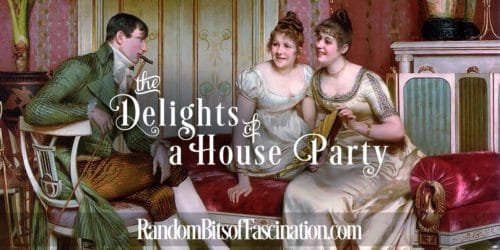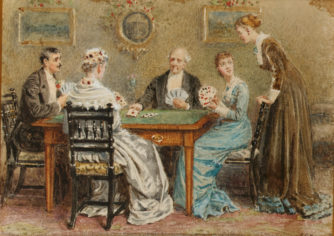What to Do at a House Party

Just how did one entertain guests at a house party?
If one braved the dangers of travel and the burden of the expenses, what did one actually do at a house party?
The reality was probably a bit different from what a modern guest might expect. During the day, guests were largely responsible for their own entertainment, availing themselves of the amenities of the estate. Typically, the day’s activities kept the gender’s segregated until dinner, although if a couple was determined to spent some time together, it could certainly happen.
Breakfast would be set out to be enjoyed individually, according to one’s preferred time to rise. The men were often up early, enjoying a substantial breakfast before heading out for fishing, shooting or hunting. Riding and boating might also be on the agenda. If the weather were disagreeable, billiards—which ladies generally did not play—might also be an option.
Ladies often rose much later, and sometimes kept to their rooms to write letters or read before breakfast. A majority of the activities open to the ladies centered around the house. They might read, write letters, practice their music, share patterns with the other ladies and sew. (Unless they were actively doing something else, women almost always had needlework in their hands, but that’s another post…) Often neighbors would call on the visitors. as polite society demanded. Those social calls would be repaid a day or two later. Visits to local places of interest might also be arranged.
If the ladies desired outdoor amusements, they might go for walks or carriage rides, or watch the men plays sports. Certain outdoor games were considered appropriate for ladies including croquet, lawn tennis, archery, shuttlecock, and lawn bowls. It should be noted, appropriate garments would be required for these activities.
Lunch was a relatively new innovation during the Regency. Oftentimes a midday repast was an informal meal set out on the sideboards in whatever room people gathered. The dining room would not be used for such a meal. The foods served and the time a midday meal would be served would depend on the dinner hour of the house.
Dinner was the main mean of the day and the major event of most days. It could be served as early a 2 pm, although that would be considered rather low class, or as late as 6 or even 7 pm. The later the hour, the more fashionable it was considered to be. Dinner was a formal occasion and required formal dress. Men and women were expected to dress accordingly and present themselves in the drawing room about a quarter of an hour before the dinner hour. Now at last, after a day of leisure, ladies and gentlemen joined each other’s company.
Dinner was a lavish affair with typically two courses and possibly a dessert course served. Each course could consist of as many two dozen different dishes. The meal could easily last two hours or more. After dinner, typically the hostess would escort the ladies to the drawing room to allow the men some time to themselves. (As though they did not have enough of that during the day—but I digress.) During this time, men would enjoy port, cigars, and manly conversation not appropriate in front of the ladies.
While the ladies waited for the men to join them in the drawing room, they might converse, play games, perform music, and for some, be glad not to be in the company of drinking men and coarse conversation. The men might trickle in as they saw fit or might join the ladies en masse for the evening’s entertainments.

Unless they were going out to attend a public assembly (ball) or other public entertainment, the group would remain in the drawing room until they retired. Tea and light refreshments would be brought to the drawing room for the company to enjoy as they focused on the pleasing art of conversation. Games, like charades and other parlor games, board games and cards often helped pass the time. Because high-stakes gambling wreaked havoc among the upper classes, it was not unusual for hostesses to limit the amount that could be bet on games in the house. Musical performances, home theatricals and informal dances could also be employed for evening entertainments.
House parties continued to be enjoyed well into the Edwardian era. However, as transportation improved, the events grew shorter, often just a few days in length. I can’t help but image hostesses would have appreciated that change immensely.
Find out more about Regency era amusements here
Find out more about Gentlemen here
Find out more about Ladies here
Find out more about House Parties here
If you’d like to read more about dinner parties in the regency era, click HERE
References
Hatch, Donna. “Regency House Parties.” Donna Hatch. June 15, 2018. Accessed May 10, 2019. https://donnahatch.com/regency-house-parties/.
Scott, Regina. “The Delights of a Regency House Party.” Regina Scott. Accessed May 10, 2019. http://www.reginascott.com/houseparty.html.
Lane, Maggie. Jane Austen and Food. London: Hambledon Press, 1995.
Pool, Daniel. What Jane Austen Ate and Charles Dickens Knew. New York: Simon and Schuster,1993.
If you enjoyed this, you might also enjoy:

I’m so glad house parties like this are no longer held. I would have hated it, both as a host or as a guest!
If I was fortunate enough to have Darcy as a husband I certainly wouldn’t like to spend most of the day either separated or surrounded by others! ?
Even if I was single I can’t imagine spending all day everyday like this (I would prefer to stay in my room with access to a library ?)
Thank you for sharing this Maria.
I second Glynis. Nope… no way. You are never really sure who the other guest will be and you are stuck for weeks at the beck and call of either the hostess or the other guests who invariably need another person to round out a group. Good grief, to be hostess to this mess would be maddening. You would really have to know your people. Those that are compatible and those that are not? Is anyone currently at odds with the others? Rejected/spurned former lovers and current lovers that should not be in company with each other. Age considerations and the need for sufficient chaperones. Grrr!! The seating arrangements around the table would be a nightmare? Then you have the political and religious considerations, class distinctions, connections, interests and all those niceties that drive a hostess mad. I’m half crazy just thinking about it. This was very interesting.